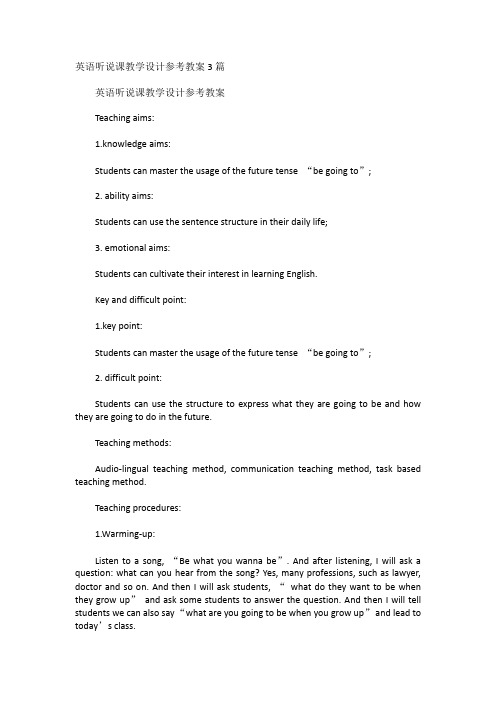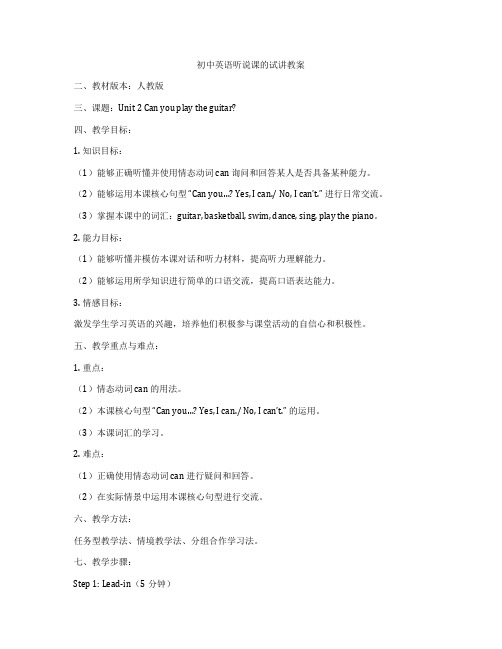英语听说课教案
大学进阶英语听说课程教案

教学目标:1. 培养学生运用英语进行口头交流的能力,提高英语听说水平。
2. 增强学生对英语语音、语调、语速的感知和模仿能力。
3. 培养学生的英语思维习惯,提高英语实际应用能力。
4. 增强学生对英语国家文化背景的了解,提高跨文化交际能力。
教学内容:1. 英语语音、语调、语速的基本知识2. 英语日常生活中的常用口语表达3. 英语国家文化背景知识4. 英语听说技巧训练教学过程:一、导入(5分钟)1. 老师简要介绍本节课的教学目标和内容。
2. 学生进行自我介绍,活跃课堂气氛。
二、语音、语调、语速训练(10分钟)1. 老师播放英语原声材料,引导学生注意语音、语调、语速的变化。
2. 学生跟读练习,注意模仿原声材料的语音、语调、语速。
三、口语表达训练(15分钟)1. 老师给出一个话题,要求学生用英语进行简短的表达。
2. 学生轮流发言,老师给予评价和指导。
四、文化背景知识讲解(10分钟)1. 老师讲解与话题相关的英语国家文化背景知识。
2. 学生提问,老师解答。
五、听说技巧训练(20分钟)1. 老师播放一段英语对话或短文,要求学生听懂大意。
2. 学生复述对话或短文内容,老师给予评价和指导。
3. 学生分组进行角色扮演,模拟实际交际场景。
六、课堂小结(5分钟)1. 老师总结本节课的学习内容,强调重点。
2. 学生分享学习心得,提出疑问。
教学评价:1. 学生在课堂上的参与度、积极性。
2. 学生对英语语音、语调、语速的模仿程度。
3. 学生口语表达的正确性、流畅性。
4. 学生对英语国家文化背景知识的掌握程度。
5. 学生在听说技巧训练中的表现。
课后作业:1. 复习本节课所学内容,巩固语音、语调、语速知识。
2. 针对课堂上的话题,用英语进行口语表达练习。
3. 查找相关英语国家文化背景知识,进行拓展学习。
教学反思:1. 根据学生的学习情况,适时调整教学内容和教学方法。
2. 关注学生的个体差异,给予针对性的指导。
3. 创设真实的语言环境,提高学生的英语实际应用能力。
生活英语听说 教案

生活英语听说教案教案标题:生活英语听说教案目标:1. 帮助学生提高生活英语听力和口语能力。
2. 培养学生运用英语进行日常生活交流的能力。
教学重点:1. 学习常用的日常生活英语词汇和表达方式。
2. 培养学生的听力理解能力,能够听懂简单的日常对话。
3. 提高学生的口语表达能力,能够运用学到的词汇和句型进行简单的日常交流。
教学准备:1. 多媒体设备,如投影仪或电视。
2. 生活英语听力材料,如录音或视频。
3. 学生练习用的练习册或工作纸。
教学过程:Step 1: 引入(5分钟)使用多媒体设备播放一段生活英语对话,引起学生的兴趣,并激发他们学习英语的动机。
Step 2: 听力训练(15分钟)播放一段简短的生活英语对话,要求学生仔细听并理解对话内容。
然后,提问学生关于对话的问题,鼓励他们用英语回答。
Step 3: 词汇和表达学习(15分钟)介绍一些常用的日常生活英语词汇和表达方式,如问候语、道歉、询问时间等。
通过示范和练习,帮助学生掌握这些词汇和表达方式。
Step 4: 口语练习(20分钟)分成小组,让学生进行口语练习。
每个小组选择一个日常生活场景,如购物、就餐等,模拟真实情境进行对话练习。
鼓励学生使用之前学到的词汇和表达方式进行交流。
Step 5: 总结和反馈(5分钟)总结本节课所学内容,并给予学生反馈。
鼓励学生继续练习和运用所学的生活英语。
教学延伸:1. 鼓励学生多听多说,提高英语听力和口语能力。
2. 提供更多的生活英语听力材料,让学生进行自主学习和练习。
3. 定期组织英语角或英语沙龙活动,提供实践口语的机会。
教案评估:1. 观察学生在口语练习中的表现,评估其口语表达能力。
2. 收集学生的练习册或工作纸,评估其对所学词汇和表达方式的掌握程度。
3. 定期进行听力测试,评估学生的听力理解能力。
希望以上教案能为您提供专业的教案建议和指导,帮助您有效地教授生活英语听说课程。
英语听说课教学设计参考教案3篇

英语听说课教学设计参考教案3篇英语听说课教学设计参考教案Teaching aims:1.knowledge aims:Students can master the usage of the future tense “be going to”;2. ability aims:Students can use the sentence structure in their daily life;3. emotional aims:Students can cultivate their interest in learning English.Key and difficult point:1.key point:Students can master the usage of the future tense “be going to”;2. difficult point:Students can use the structure to express what they are going to be and how they are going to do in the future.Teaching methods:Audio-lingual teaching method, communication teaching method, task based teaching method.Teaching procedures:1.Warming-up:Listen to a song, “Be what you wanna be”. And after listening, I will ask a question: what can you hear from the song? Yes, many professions, such as lawyer, doctor and so on. And then I will ask students, “what do they want to be when they grow up”and ask some students to answer the question. And then I will tell students we can also say “what are you going to be when you grow up”and lead to today’s class.2. Pre-listening:I will show some pictures on the PPT, the first picture is about reporter and the second picture is about the article. I will write down the two words on the blackboard and then I will ask the students to read after me.3. While-listening:I will ask students to listen to the radio for the first time and then match the sentence with the picture on the ppt. The first picture is about the reporter, thee second picture is about writing magazines and the third picture is about Shanghai.Then I will ask students to listen to the radio for the second time and after listening, I will ask them to answer three questions on the blackboard, the first one is “What is he going to do when he grows up”, the second one is “how is he going to do for that”and the third one is “where is he going to work”.Lastly, I will ask students to listen to the radio for the third time and they need to read after the radio. And then I will divide the students into two groups, group A acts as A, and group B acts as B, and read the passage.4. Post-listeningWe will play a game called “hot potato”. When the music begins to play, students need to pass the flower. And when the music stops, the students who is holding the flower need to answer the question about “what is he going to do when he grows up, how is he going to do for that or where is he going to work”.And then we will have a group work, four students as a group and students need to make a survey about what is their group members going to be, how is he or she going to do for that and where is he going to work. Five minutes later, I will ask some groups to show their report.5. Summary and homeworkI will ask students to read the passage to summarize what we have learned today. After class, they need to search more information about the job they want to do.Blackboard designWhat are you going to be when you grow up?How are you going to do for that?Where are you going to work?英语听说课教学设计参考教案一、《英语课程标准》对初中阶段听、说的技能要求准确定位教学目标和宏观把握教学设计的依据是《课标》中规定的各级目标,教师要全面了解各学段的目标,以使自己在教学设计中能更好、更准确地把握。
高中英语听说课教案模板(共6篇)

高中英语听说课教案模板〔共6篇〕第1篇:高中英语听说课新课标下的听说教学高一英语新课程改革已经在全国范围内逐步推行,我省也已经正式步入课改的行列之中。
英语学科新课改的重点是改变过去只注重语法和词汇知识的讲解与传授,无视对学生实际语言运用才能的培养的倾向。
强调从学生的学习兴趣、生活经历和认知程度出发,倡导体验、理论、参与、合作交流的学习方式和任务型的教学途径,开展学生的综合语言运用才能。
因此,进步听力教学是所有英语老师必需要考虑的一个课题。
《英语课程标准》也将听、说技能的地位进一步提升。
而中学英语教学由于长期受应试教育的影响,过多重视了英语知识的训练和掌握,致使学生对听力的认识还是茫然的。
面对这样的境遇,又恰逢在新课程改革的指引下如何搞好听、说教学是摆在我们所有英语老师面对的一个课题,也是一个迫在眉睫的问题。
一、听〔一〕形成对英语听才能要求的正确认识新课标逐年加大听力局部的分值。
目前,英语口试还不作一般考试的要求,所以,学生不会创造气氛去说英语。
基于这种情况,我们应努力让学生理解,好的听力不仅对笔试有帮助,它更是一种才能的表达,因为我们学英语的目的不是为了考试,考试是作为一种催促的手段,我们的目的是用英语来进展交际。
口头交流是最简单最普遍的交际方式。
而只有我们在听得懂别人说的话和说得出自己的观点时,我们才有交流。
所以说,听懂说好英语既是我们学习的目的,也是学习英语的根本要求。
〔二〕听前准备听前的准备工作是非常重要的,一般情况下老师只是留几分钟时间让学生自己看要答复的问题,或在多媒体课件上列出一些听力内容中的生词、词组后就让学生听了。
听完后直接对答案。
但对于那些内容较难的听力材料,我们除了做以上工作外还应该给学生讲解一些关于听力材料的背景知识,把它当作听前的热身。
可以先让学生们看问题和与它相对应的选项,在他们看完以后,我让他们猜想听力材料的大致内容。
多数同学猜不出来,少数能猜出来的同学也不敢答复。
这时可以在黑板上列出了以下一些【关键词】:^p 。
初中英语听说课的试讲教案

初中英语听说课的试讲教案二、教材版本:人教版三、课题:Unit 2 Can you play the guitar?四、教学目标:1. 知识目标:(1)能够正确听懂并使用情态动词 can 询问和回答某人是否具备某种能力。
(2)能够运用本课核心句型“Can you…? Yes, I can./ No, I can’t.” 进行日常交流。
(3)掌握本课中的词汇:guitar, basketball, swim, dance, sing, play the piano。
2. 能力目标:(1)能够听懂并模仿本课对话和听力材料,提高听力理解能力。
(2)能够运用所学知识进行简单的口语交流,提高口语表达能力。
3. 情感目标:激发学生学习英语的兴趣,培养他们积极参与课堂活动的自信心和积极性。
五、教学重点与难点:1. 重点:(1)情态动词 can 的用法。
(2)本课核心句型“Can you…? Yes, I can./ No, I can’t.” 的运用。
(3)本课词汇的学习。
2. 难点:(1)正确使用情态动词 can 进行疑问和回答。
(2)在实际情景中运用本课核心句型进行交流。
六、教学方法:任务型教学法、情境教学法、分组合作学习法。
七、教学步骤:Step 1: Lead-in(5分钟)1. 教师与学生用中文进行简单的自我介绍,包括自己的姓名、年龄、爱好等。
2. 引导学生用中文讨论自己的同学,询问他们是否具备某些特长或技能,如:“你能唱歌吗?”“你会跳舞吗?”等。
Step 2: Presentation(10分钟)1. 教师展示本课课题“Can you play the guitar?”,引导学生猜测课题内容。
2. 教师通过图片和实物展示本课词汇:guitar, basketball, swim, dance, sing, play the piano。
3. 教师展示本课核心句型“Can you…? Yes, I can./ No, I can’t.”,并进行示范。
英语初中教案模板听说

英语初中教案模板听说课时安排:2课时(90分钟)教学目标:1. 学生能够听懂并准确使用目标词汇描述日常生活物品。
2. 学生能够通过听力材料理解日常生活中的指令和信息。
3. 学生能够在小组活动中用英语进行简单的交流和讨论。
4. 学生能够通过听力和口语活动提高自己的语言运用能力。
教学内容:1. 词汇:衣物、颜色、尺寸等。
2. 功能句型:询问衣物颜色、大小、价格等。
3. 听力材料:日常生活中的购物场景。
教学步骤:第一课时:一、热身(5分钟)1. 教师与学生进行简单的自由对话,询问学生近期的学习和生活情况。
2. 学生进行小组活动,用英语介绍自己的学习和生活情况。
二、新课导入(10分钟)1. 教师展示衣物、颜色、尺寸等词汇的图片,引导学生用英语描述。
2. 学生通过小组活动,用目标词汇进行交流和讨论。
三、听力训练(15分钟)1. 教师播放听力材料,学生听后回答相关问题。
2. 学生进行小组活动,根据听力材料进行角色扮演。
四、口语练习(10分钟)1. 教师创设购物场景,引导学生用英语进行购物对话。
2. 学生进行小组活动,模拟购物场景进行对话练习。
第二课时:一、复习(5分钟)1. 教师通过提问方式复习上节课的目标词汇和功能句型。
2. 学生进行小组活动,用英语进行复习对话。
二、听力训练(15分钟)1. 教师播放听力材料,学生听后回答相关问题。
2. 学生进行小组活动,根据听力材料进行角色扮演。
三、口语练习(10分钟)1. 教师创设购物场景,引导学生用英语进行购物对话。
2. 学生进行小组活动,模拟购物场景进行对话练习。
四、总结与作业(5分钟)1. 教师对本节课的学习内容进行总结,强调重点和难点。
2. 学生进行小组活动,用英语总结本节课的学习内容。
3. 教师布置作业,要求学生课后进行听力练习和口语练习。
教学评价:1. 课后收集学生的听力练习和口语练习作业,对学生的学习情况进行评价。
2. 在下一节课开始时,教师可以抽取部分学生进行听力测试和口语展示,以检验学生的学习效果。
初中英语听说课教案范文全英文版

初中英语听说课教案范文全英文版全文共3篇示例,供读者参考篇1Middle School English Listening and Speaking Lesson PlanI. Lesson Objectives:1. Students will be able to listen to spoken English and understand the main idea and important details.2. Students will be able to speak English fluently and accurately in a variety of situations.3. Students will be able to communicate effectively in English by using appropriate vocabulary and grammar.II. Materials Needed:1. Audio recordings of native English speakers2. Pictures or cards for vocabulary and discussion activities3. Worksheets for listening and speaking exercises4. Whiteboard or blackboard for writing key points and vocabularyIII. Procedure:1. Warm-up (5 minutes): Play a short audio clip of English conversation and ask students to listen and discuss what they heard in pairs. This will help students get into the listening mode and activate their listening skills.2. Vocabulary Introduction (10 minutes): Introduce new vocabulary related to the audio clip or the theme of the lesson. Use pictures or cards to help students understand and remember the words better.3. Listening Activity (20 minutes): Play an audio recording ofa native English speaker talking about a specific topic. Ask students to listen carefully and take notes on the main points and important details. After the recording, lead a class discussion on what they heard and check their understanding.4. Speaking Practice (20 minutes): Divide students into small groups and give them a speaking task related to the listening activity. For example, ask them to discuss their opinions on the topic, role-play a conversation based on the audio clip, or make a presentation using the information they learned.5. Feedback and Evaluation (10 minutes): Provide feedback on students' language use and communication skills during the speaking practice. Encourage peer evaluation andself-assessment to help students improve their English proficiency.6. Wrap-up (5 minutes): Review the key vocabulary and language structures learned in the lesson. Assign homework or additional speaking activities for students to practice outside of class.IV. Assessment:1. Listening comprehension: Evaluate students' ability to understand spoken English and follow the main ideas and details.2. Speaking fluency: Assess students' ability to speak English confidently and fluently in a variety of situations.3. Vocabulary and grammar: Evaluate students' use of appropriate vocabulary and grammar in their speaking activities.V. Extension Activities:1. Listen to more audio recordings of different accents and speech patterns to expose students to a variety of English language styles.2. Conduct pair or group discussions on different topics to practice speaking and listening skills in a more interactive setting.3. Organize a speaking competition or debate among students to enhance their communication and presentation skills in English.Overall, this lesson plan aims to improve students' listening and speaking skills in English through interactive and engaging activities. By providing opportunities for students to listen to authentic language input and practice speaking in meaningful contexts, they will develop the confidence and proficiency needed to communicate effectively in English.篇2Middle school English Listening and Speaking Lesson PlanLesson Title: Introducing YourselfGrade Level: Middle schoolObjective: Students will be able to introduce themselves and talk about their likes, dislikes, and interests in English.Materials: Whiteboard, markers, flashcards with vocabulary words, pictures of different activitiesWarm-up (10 minutes):- Begin the lesson by asking students to stand up and form a circle.- Lead them in a game of passing a ball around the circle while saying their names.- This will help students get comfortable speaking in English and creating a positive classroom atmosphere.Introduction (5 minutes):- Write the following questions on the board: What is your name? How old are you? Where are you from?- Explain that today's lesson will focus on introducing themselves in English and talking about their likes and dislikes.Presentation (15 minutes):- Use flashcards with vocabulary words related to hobbies, likes, and dislikes.- Give examples of sentences like "I like swimming" or "I don't like playing video games" and ask students to repeat after you.- Show pictures of different activities and ask students to talk about whether they like or dislike them.Practice (20 minutes):- Divide students into pairs and have them take turns introducing themselves to each other.- Encourage them to ask questions and find common interests.- Walk around the classroom and listen to students speaking in English, offering help and corrections as needed.Production (15 minutes):- Have each student stand up and introduce themselves to the class.- Encourage them to use the vocabulary and sentence structures they have learned.- After each student has introduced themselves, ask the class to guess their likes and dislikes based on their presentation.Wrap-up (5 minutes):- Review the vocabulary and sentence structures learned in the lesson.- Encourage students to continue practicing introducing themselves in English outside of the classroom.- Assign homework to write a short paragraph about themselves, including their name, age, hometown, and likes and dislikes.Extension:- For advanced students, have them create a dialogue with a partner where they introduce themselves and have a conversation about their interests.- Play a game where students have to guess each other's likes and dislikes based on clues given by their partner.This lesson plan is designed to help middle school students improve their English listening and speaking skills through interactive activities and practice. By focusing on introducing themselves and talking about their likes and dislikes, students will become more confident in using English in real-life situations.篇3Middle School English Listening and Speaking Lesson PlanI. Lesson Title: My HobbiesII. Objectives:1. Students will be able to introduce themselves and talk about their hobbies.2. Students will practice listening to a conversation about hobbies.3. Students will practice speaking about their own hobbies.III. Materials Needed:1. Whiteboard and markers2. Audio recording of a conversation about hobbies3. Handouts with vocabulary related to hobbiesIV. Procedure:1. Warm-up (10 minutes):- Begin the lesson by asking students to share their favorite hobbies with the class.- Write down some of the hobbies on the board and discuss them briefly.- Introduce the topic of the lesson: My Hobbies.2. Listening (15 minutes):- Play the audio recording of a conversation between two people talking about their hobbies.- After the recording, ask students some comprehension questions to check understanding.- Discuss any new vocabulary that was introduced in the conversation.3. Speaking (20 minutes):- Divide the class into pairs and ask students to talk to their partner about their own hobbies.- Encourage students to ask follow-up questions and engage in a conversation with their partner.- Walk around the class and monitor the students' discussions, offering feedback and assistance where needed.4. Vocabulary Practice (10 minutes):- Hand out the vocabulary handouts to the students.- Have students work in pairs or small groups to match the hobbies with their definitions.- Review the answers as a class and discuss any questions or misunderstandings.5. Role Play (15 minutes):- Divide the class into groups of four.- Assign each group a scenario related to hobbies (e.g. planning a weekend activity, discussing a new hobby).- Have students perform the role play in front of the class.- After each role play, provide feedback on the students' performance and language use.6. Wrap-up (5 minutes):- Review the main points of the lesson and ask students to share one thing they learned or enjoyed.- Assign homework for the next class, such as writing a short paragraph about their favorite hobby.V. Assessment:- Students will be assessed on their ability to participate in the speaking activities, engage in conversations with their peers, and use vocabulary related to hobbies accurately.VI. Extension Activities:- Have students create a poster or presentation about their hobbies to share with the class.- Organize a hobby fair where students can display and talk about their hobbies with their classmates.VII. Reflection:- After the lesson, reflect on what went well and what could be improved for future lessons on the topic of hobbies in English listening and speaking.。
英语听说课教资教案模板范文

一、教学目标1. 语言技能目标:学生能够听懂日常生活中的英语对话,并能用英语进行简单的口头交流。
2. 知识目标:学生能够掌握常用的英语口语表达方式和常用词汇。
3. 情感态度目标:培养学生对英语学习的兴趣,提高学生自信心,鼓励学生在课堂上积极参与。
二、教学重难点1. 教学重点:掌握日常生活中的英语口语表达方式和常用词汇。
2. 教学难点:学生在实际情境中运用英语进行口头交流。
三、教学过程1. 导入- 利用多媒体展示日常生活场景,激发学生的学习兴趣。
- 引导学生思考:在这样的场景下,我们应该用英语说什么?2. 听力训练- 播放一段日常生活场景的英语对话,让学生认真聆听。
- 提问:对话中出现了哪些词汇和表达方式?学生能否用英语复述对话内容?3. 口语练习- 教师根据听力内容,设计几个实际情境,让学生进行角色扮演。
- 学生分组练习,教师巡回指导,纠正发音和语法错误。
4. 词汇拓展- 教师展示一些与日常生活相关的英语词汇,引导学生学习。
- 学生跟读并模仿,加深对词汇的记忆。
5. 语法讲解- 教师讲解日常生活中的常用英语语法知识。
- 学生通过例句理解语法规则,并尝试运用到实际对话中。
6. 练习巩固- 学生进行小组练习,用所学词汇和语法知识进行对话。
- 教师点评,纠正发音和语法错误。
7. 小结作业- 总结本节课所学内容,强调重点和难点。
- 布置课后作业,要求学生用所学知识进行口语练习。
四、板书设计1. 课堂主题:英语听说课2. 词汇:日常生活相关词汇3. 语法:常用英语语法知识4. 教学目标:听懂日常生活中的英语对话,能用英语进行简单的口头交流五、教学反思1. 关注学生的学习兴趣,创设生动有趣的课堂氛围。
2. 注重培养学生的口语表达能力,鼓励学生在课堂上积极参与。
3. 加强对学生口语发音和语法的指导,提高学生的英语水平。
4. 定期进行教学反思,不断改进教学方法,提高教学质量。
- 1、下载文档前请自行甄别文档内容的完整性,平台不提供额外的编辑、内容补充、找答案等附加服务。
- 2、"仅部分预览"的文档,不可在线预览部分如存在完整性等问题,可反馈申请退款(可完整预览的文档不适用该条件!)。
- 3、如文档侵犯您的权益,请联系客服反馈,我们会尽快为您处理(人工客服工作时间:9:00-18:30)。
2T:Is … your favorite subject
S: No, ….
T: Why don’t you like …
S: Because it’s difficult/ boring…
3. S1:What’s your favorite subject
S2: My favorite subject is …
---How do you like your beef, rare, medium, or well-done
---Which do you prefer, tea or coffee
……
Teaching aims
Learn to talk about somebody’s favoritefood.
Teachingkey points
prefer….to…..的表达
I’d like bread with jam for breakfast.的表达
Teaching difficulties
prefer….to…..的表达
I’d like bread with jam for breakfast.的表达
______’s favorite subject is___________.
Step 6:Consolidation
New words: subject, ., science, history, biology, because
Sentences:
--- What’s your favorite subject
T: Do you have a Chinese lesson today
S: Yes,…./No, ….
T: Do you have a math lesson today
S: Yes, …./No,…
T: Who is your math teacher
S: ….
Step 2: Presentation
Lwords: subject, ., science, history, biology, because
--- What’s your favorite subject
--- My favorite subject is …
--- Why do you like …
S3: Because…
Step 5: Oral practice:
Let students talk about it by their own ways.
Name:
Favorite subject
Reason
teacher
Description of teacher
I:
S1:
S2:
Report:
My name is __________.
My favorite subject is __________
because it is ________.
My ________ teacher is _________.
I like her/him very much.
She/ He is really ___________.
S1: Why do you like …
S2: Because…. What about you
S1: ….
(S3 and S4 make a similar conversation in turns)
S1:What’s S4’s favorite subject
S3: His/ Her ….
S1:Why does he/she….
S: We have math/English/Chinese….
Focus attention on the word list and the example: Say: Number 1 is C, tennis racket. Match the words and picture. check the answers.
--- Because it’s …
Reflection
The lesson went on well. Students were quite excited and motivated. But not enough time was given at the practicestage so some students still have difficulties talking about somebody’s favorite subjects and give reasons. More practice and checking are needed for these students in the next lesson.
Teaching Plan for Unit7I’d like coffee without cream
Teaching contents
New words:beef, rare, medium, well-done, raw, jam, etc.
--- Whatkind of food would you like, Chinese or American
T:What kind of food would you like, Chinese or American
S:I like…
T: What subjects do we have this year
S: We have math/English/Chinese ….
T: What subjects do we have in middle school
Step 3: Listening and repeat
Let students listen to the tape and speak the answer and repeat it :
T: Let’s listen to the tape and circle the subjects in 1a you hear.
--- My favorite subject is …
--- Why do you like …
-- Because it’s …
Homework
1.Listen and read after the tape for thirty minutes.
2.Write down the Chinese meaning of the new words and key sentences, then translate them into English.
T:Do you know what are these
S:Hamburger, French fries, milk ,beef, etc.
T: Who is this woman/man
S: She/he is Miss/ Mr. …. She/ He is our Chinese teacher.
Teaching methods
Task-based language teaching and communicative language teaching
Teaching aids
pictures, multi-media.
Teaching procedures
Step 1: Warm-up
Show some pictures of food.
S: Now let’s check the answers. The boy’s favorite subject is science. And the girl likes art and math, but her favorite subject is music.
Step 4: Listen and speak
Let students listen to the tape and talk about it :
T: Listen to the tape and talk about it.
1. S1: What’s your favorite subject
S2: My ….
S1: Why do you like…
